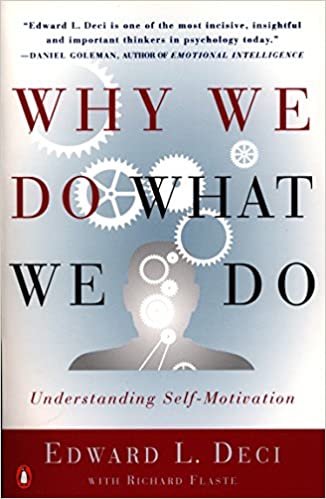Why We Do What We Do by Edward L. Deci
The Book in 1 Sentences
Why We Do What We Do: Understanding Self-Motivation
“The prescriptions begin with an understanding of people’s motivation—of the extent to which it is autonomous—and they involve using that understanding to manage ourselves more effectively, to related differently to others, and to make more meaningful social policy.” ~ Edward L. Deci
5 BIG Ideas
1. Intrinsic Vs Extrinsic Goals!
2. “The starting place for change is accepting oneself and taking interest in one’s inner world.”
3. True Self-esteem Vs Contingent Self-esteem.
4. Internalization: Introjection, Integration.
5. “Allow yourself to fail and you will be more likely to succeed.”
Why We Do What We Do Book Summary
1. Intrinsic Vs Extrinsic Goals
“The researchers found that if any of the three extrinsic aspirations—for money, fame, or beauty—was very high for an individual relative to the three intrinsic aspirations, the individual was also more likely to display poorer mental health.
For example, having an unusually strong aspiration for material success was associated with narcissism, anxiety, depression, and poorer social functioning as rated by a trained clinical psychologist…
In contrast, strong aspirations for any of the intrinsic goals—meaningful relationships, personal growth, and community contributions—were positively associated with well-being.
People who strongly desired to contribute to their community, for example, had more vitality and higher self-esteem.
When people organize their behavior in terms of intrinsic strivings (relative to extrinsic strivings) they seem more content—they feel better about who they are and display more evidence of psychological health.”
2. Focusing on Extrinsic Goals
“Recall that the first finding indicated that if people held extrinsic goals very dear, they had tenuous mental health.
The second important finding was that, even if the respondents thought the chances of achieving the dearly held extrinsic goals were excellent, they still displayed poor mental health.
Holding extrinsic aspirations and believing they won’t be able to achieve them will surely leave people dyspeptic, but the less obvious and more penetrating finding from this research is that holding very strong extrinsic aspirations and believing strongly that they will be able to achieve them was also associated with poorer psychological health.
It is more the type of aspirations people hold very strongly than the expectations they have about achieving them that is the critical predictor of well-being.”
3. Focusing on Intrinsic Goals
“Whereas earlier studies had focused on issues like the quality of one’s performance and experience, these studies drew direct linkages between the types of motivation and individual’s mental health.
It seems that people who are the healthiest focus on developing satisfying personal relationships, growing as individuals, and contributing to their community.
Surely, they also aspire to sufficient financial success to live comfortably. But wealth, fame, and beauty do not disproportionately occupy the consciousness of these people the way they dominate the experiences of individuals who are less psychologically stable.”
“Sure, money motivates, but that’s not the point. The point is that while money is motivating people, it is also undermining their intrinsic motivation and, as we would later discover, having a variety of other negative effects as well.”
4. to Be Authentic
“Authenticity necessitates behaving autonomously, for it means being the author of one’s actions—acting in accord with one’s true inner self. The key to understanding autonomy, authenticity, and self is the psychological process called integration.
Various aspects of a person’s psyche differ in the degree to which they have been integrated or brought into harmony with the person’s innate, core self.
Only when the processes that initiate and regulate an action are integrated aspects of one’s self would the behavior be autonomous and the person, authentic. It is in this sense that to be authentic is to be true to one’s self.”
“The starting place for change is accepting oneself and taking interest in one’s inner world.”
5. Narcissism Vs Authenticity
“Lasch, for example, describes American culture as having a narcissistic preoccupation with the self. He might be right about a narcissistic preoccupation in this culture, but it is not a preoccupation with the self.
On the contrary, narcissism involves desperately seeking affirmation from others. It entails an outward focus—a concern with what others think—and that focus takes people away from their true self.
The narcissistic preoccupation results not from people’s being aligned with the self but from their having lost contact with it.
They adopt narcissistic values in a controlling society because they have not had the type of psychological nourishment they need to develop an integrated and healthy self.
Narcissism is not the result of authenticity or self-determination, it is their antithesis.”
6. to Be Authentic & Responsible!
“Ryan and I put stock in the humanistic belief that it is important to be authentic, to be oneself, to march to own’s one drummer.
But just as obviously, we put stock in the importance of being responsible. To advocate autonomy does not mean to call for self-indulgence, because being truly oneself involves accepting responsibility for the well-being of others...”
“Because being true to oneself has often been equated with the egoistic doing of one’s own thing, authenticity has often been perversely interpreted as justification for irresponsibility and then attacked by the critics who so interpret it.
The selfish, egoistic doing of one’s own thing is in fact irresponsible and may have demonstrably negative consequences. But those behaviors are not authentic; they are not expressions of human autonomy; they are not instances of being one’s true self.”
7. True Self-esteem Vs Contingent Self-esteem
“We refer to them as true self-esteem and contingent self-esteem. True self-esteem represents a sound, stable sense of oneself, built on a solid foundation of believing in one’s worth as a human being.
It accompanies a well-developed true self in which intrinsic motivation has been maintained, extrinsic limits and regulations have been well integrated, and the processes necessary for regulating one’s emotions have been developed. True self-esteem thus accompanies freedom and responsibility.
True self-esteem is not, however, the same thing as thinking you can do no wrong. People with true self-esteem have a sense of whether behaviors are right or wrong because true self-esteem is accompanied by integrated values and regulations. Such individuals evaluate their behaviors, but their feelings of worth are not riding on those behaviors.”
8. Noncontingent Positive Regard
“Carl Rogers advocated what he called noncontingent positive regard. In essence, he was suggesting that regard from others (and, most importantly, from ourselves) is our inalienable right.
We are worthy by virtue of the fact that we are alive. Praise is usually different. It is typically made contingent on getting an A on an exam, eating all those vegetables, or cleaning your room. Its hidden message is that you would not be worthy if you had not hit the target.
Praise runs the risk of bolstering contingent self-esteem rather than true self-esteem, and in the process it strengthens a controlling dynamic in which people become dependent on the praise.
They then behave to get more praise so they will feel worthy—even if only for a moment. And in so doing, they further erode their autonomy.”
9. Internalization: Introjection, Integration
“The two forms of internalization are: introjection, which Fritz Perls likens to swallowing a rule whole rather than digesting it; and integration, which involves “digestion” and is the optimal form of internalization...
Autonomous functioning requires that an internalized regulation be accepted as your own; the regulation must become part of who you are. It must be integrated with your self...
People often take in the values and rules of groups to which they belong, and they subsequently act accordingly. When this process occurs only incompletely, it results in introjects—that is, in internalizations that take the form of “shoulds” and “oughts.”
Introjects are voices in one’s head, so to speak, that come from the outside and issue orders—sometimes like mean-spirited drill sergeants and sometimes like loving and well-meaning (but nonetheless intrusive) aunts.
When internalizations become integrated, when they become true aspects of who one is, they allow more authentic actions and interactions.”
10. Allow Yourself to Fail
“Allow yourself to fail and you will be more likely to succeed.”
In the great book The Pursuit of Perfect, Tal Ben-Shahar says: “One of the wishes that I always have for my students is that they should fail more often (although they are understandably not thrilled to hear me tell them so).
If they fail frequently, it means that they try frequently, that they put themselves on the line and challenge themselves.
It is only from the experience of challenging ourselves that we learn and grow, and we often develop and mature much more from our failures than from our successes.
Moreover, when we put ourselves on the line, when we fall down and get up again, we become stronger and more resilient.”
11. Motivation Must Come from Within
“When it comes to issues of motivation, people always seem to want techniques for motivating or managing themselves. Screaming from the front cover of most self-help books are statements about “The newest techniques for motivating yourself,” or “Techniques that have proven effective.”
The truth is that there are no techniques that will motivate people or make them more autonomous. Motivation must come from within, not from techniques. It comes from their deciding they are ready to take responsibility for managing themselves.
When people are really ready to change for their own personal reasons, and when they are willing to face and cope with the myriad feelings—anxiety, inadequacy, rage, terror, or loneliness—that underlie the motivation for change.
Once that has happened, various techniques may be useful for them, but without a true resolve, without reasons for change that are personally important, techniques will not help.
When people put stock in techniques as something that will change them, they are expressing an external locus of causality rather than an internal one; they are holding the misguided belief that being controlled rather than autonomous is the means for bringing about meaningful, personal change.
A deep personal desire to change must come first. Then perhaps, a technique can give people a little help.”
That was my QUICK Why We Do What We Do book summary. If you’re interested, get your copy. There is a HUGE amount of wisdom and life-changing ideas in this book, and we’ve only touched on a tiny bit of it.
Buy The Book: Why We Do What We Do by Edward L. Deci

GET Blinkist 7 Days FREE Trial
3000+ Book Summaries
(Audio and Text)





